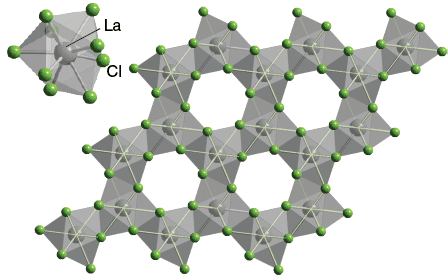Formula LaCl3 Melting point 858 °C Boiling point 1,000 °C | Molar mass 245.26 g/mol Density 3.84 g/cm³ | |
 | ||
Appearance white odorless powder; hygroscopic | ||
Lanthanum chloride is the inorganic compound with the formula LaCl3. It is a common salt but is mainly used in research. It is a white solid that is highly soluble in water and alcohols.
Contents
Structure
The La3+ centre is 9-coordinate in the trichloride. The structure is similar to that for uranium trichloride.
Preparation and reactions
It forms upon union of the elements, but a more commonly used method involves heating a mixture of lanthanum(III) oxide and ammonium chloride at 200-250 °C:
La2O3 + 6 NH4Cl → 2 LaCl3 + 6 NH3 + 2 H2OFrom the trichloride, one can produce the other trihalides by exchange. Reduction with potassium gives metallic lanthanum.
Uses
Lanthanum chloride does not have many applications. A possible application involves the precipitation of phosphate from solutions, e.g. in swimming pools to prevent algae growth. It has also shown use as a filter aid and an effective flocculent. Lanthanum chloride is also used in biochemical research to block the activity of divalent cation channels, mainly calcium channels. Doped with cerium, it is used as a scintillator material.
In organic synthesis, lanthanum trichloride functions as a mild Lewis acid for converting aldehydes to acetals.
The compound has been identified as a catalyst for the high pressure oxidative chlorination of methane to chloromethane with hydrochloric acid and oxygen.
This compound is also used in Gamma Detectors, is one of the smallest sized (massed) meters of the inorganic compounds used for Gamma Ray Detectors.
Lanthanum chloride is also frequently used as an ionisation suppressant in Atomic Emission spectroscopy.
